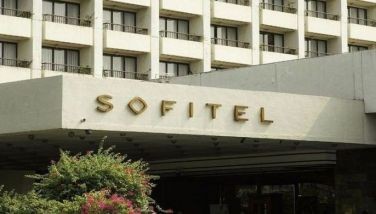Voting too slow – Comelec
MANILA, Philippines - Dilly-dallying by voters at polling booths may cause delays in the overall electoral process on May 9 as initially shown by the outcome of yesterday’s mock polls in selected areas in the country.
“It’s slow. It took 11 minutes for the first voter in Baseco to vote. Eleven minutes is too long but, of course, we are (still) trying to get into the groove,” said Commission on Elections (Comelec) Chairman Andres Bautista, when sought for comment on how the mock elections had turned out.
He said most voters in the mock polls were observed to be taking their time in selecting their “candidates.”
He was referring to 26-year-old Lawrence Panis who was first to vote at the H. Atienza Elementary School in Baseco, Manila.
The 11 minutes, he said, did not include other election procedures like feeding of the ballot into the vote counting machine (VCM), and putting indelible ink on his finger.
Panis later told reporters he could not read the font on the ballots and that he was going through the names of the candidates he did not know.
The poll chief also observed that voters were arriving in trickles during the first hour of voting.
“I just hope that on election day, this will not be the scenario in our polling places. I hope our voters will come early to vote,” he maintained.
The Comelec held the mock elections yesterday to get a preview of what might happen on election day on May 9.
The poll body simulated the entire voting process from preparation, voting, counting, consolidation, canvassing and transmission of votes from the polling centers to the canvassing centers to the national data center based at the agency’s warehouse in Sta. Rosa, Laguna.
A random manual audit was also performed to test the accuracy of the VCM.
Correction
Bautista noted that through the mock exercise, the Comelec would be able to detect which aspect of the election process they should improve.
The mock polls were done after the Comelec was able to correct the errors found last week by SLI Global Solutions, the Denver-based international certifier, on the source codes of consolidation and canvassing system (CCS) and the VCM.
SLI found that the CCS source code was not compatible with the election management system (EMS) which contains vital information like the name of candidates, ballot serial numbers and specific details about certain polling precincts.
At the Robinsons Place Mall in Malate – one of the venues of the mock polls – registered voters from nearby communities were looking forward to voting at the mall on May 9.
Voter Rolly Ligtas told reporters that he was satisfied with his experience in the mock polls. “It’s okay. It’s comfortable here because there is an aircon. If you just follow the instructions, there’s no problem,” he said.
But for Msgr. Hernando Coronel, rector of Quiapo Church and priest adviser of the Parish Pastoral Council for Responsible Voting (PPCRV), he observed that the ink being used by voters to mark their choices on the ballots caused smudges that were visible underneath.
“I don’t know if it affects the ballot,” Coronel added.
Coronel said that he was expecting to see the new feature of the VCM where voters can view the votes that they cast on the verification paper audit trail (VVPAT) screen.
Arwin Serrano of the PPCRV said the Comelec should have turned on the VVPAT screen if it really wanted to simulate an actual election.
Serrano also questioned why the mock polls ran from 7 a.m. to 12 noon at participating polling precincts, except at the Baseco school and Ramon Magsaysay Elementary School in Cubao, Quezon City where the exercise lasted until 5 p.m.
According to Narciso Arabe, Comelec’s election officer for 5th District of Manila, 100 individuals were registered to vote at Robinsons Place but only 40 turned up. The poll body later allowed some members of the media to vote, raising the turnout to 66.
Arabe added that of the 66 ballots inserted into the VCM, only one ballot was rejected and it was because the voter did not shade the oval fully.
Based on tweets posted by Comelec spokesman James Jimenez on his account @jabjimenez, ballot rejections appeared to be minimal.
He cited a case at the polling precinct in Bagong Pagasa, Quezon City where one of 74 ballots was rejected “due to the marks deliberately made by voter.”
Jimenez also tweeted that at the Tenement E/S in Western Bicutan, only one of 99 ballots fed into the VCM was rejected.
Orderly in general
In Lamitan City in Basilan, Comelec observer Julius Navarro said the mock elections went generally smoothly save for some reports of paper jam and some ballots being rejected by the VCM.
He also reported good turnout of voters for the mock polls held in barangays Parang Basak and Malinis.
Other problems observed were in signal transmission and electric supply.
The conduct of mock elections in at least four polling precincts Dagupan City and in Alaminos City also went smoothly, said Pangasinan election supervisor Marino Salas.
“This is not only to test the technology that we’re going to use but of course to inform the people to disseminate information on the process that we’re going to adopt on election day,” he told local reporters at the West Central Elementary School, one of the polling precincts.
Salas also said he was surprised to see many voters at the Pugaro Elementary School in Dagupan “as if it was really an election day.”
“We’re confident the results would be 100 percent accurate,” he said.
Raymond Vinluan, 64, of Pobalcion Oeste in Dagupan said it took him time looking for the names of his favored candidates.
Julius Torres, newly designated regional director of Comelec Region 1, said it was understandable that some voters who trooped to the polling precincts for the mock polls were dismayed when they saw unfamiliar names, not their candidates,’ on the ballots.
“We understand the zealousness of the people… but the purpose of this is to show process of voting and counting. We can’t use names of actual candidates because that could be used for another purpose,” Torres said.
Pangasinan was chosen for the mock polls site due to the size of its voting population – more than 1.7 million.
It was in Pangasinan where the PPCRV organized its One Good Vote campaign.
He said for the mock polls, they tried to accommodate at least 100 voters per precinct until noon.
Salas said it would be easier and more comfortable to vote on May 9 in the province as its clustered precincts now only have 700 voters each as against 1,000 in previous elections.
Voting hours would be from 7 a.m. to 5 p.m.
“Longer voting hours and fewer voters in clustered precincts,” he said.
No printout
Meanwhile, voters will have no printed record of their votes as the Comelec has stood pat on its decision not to print the voters verification paper audit trail tape receipts to prevent vote buying as well as speed up voting procedures.
“I can tell you now – we will not activate the tape receipts. As I’ve said before, there are more disadvantages than advantages if we will print the receipts,” Bautista told reporters yesterday in an interview.
VVPAT is a feature of the VCM that produces printout of each vote cast.
The Comelec is being urged to activate this feature so that voters can see if their votes are counted.
Bautista, however, argued that tape receipts cannot only be used as proof of vote selling but can also affect “time and motion” during the elections.
Comelec said it takes approximately 13 minutes to print a tape receipt or some 2.1 hours for a precinct with 600 voters.
This is on top of the five hours needed to review the printed tape receipt, bringing the total to 7.1 hours.
If a voter is not used to going through tape receipts in grocery stores, longer time may be required to read the VVPAT tape receipts.
But Bautista said the Comelec is still studying whether to show the votes cast on the VVPAT screen.
“We are still looking into this. The problem on VVPAT screen is the time and privacy. Voters will take some time to read the VVPAT screen while their privacy can be comprised because other people may be able to see the screen,” he pointed out.
Moreover, turning on VVPAT screen entails five more hours for a polling precinct with 600 voters.
This is assuming that each voter spends 30 seconds in inspecting his or her ballot receipts onscreen.
Former elections chief Sixto Brillantes agreed that VVPAT tape receipt should not be printed but proposed that voters be given limited time to view their votes if the VVPAT screen is activated.
Meanwhile, Bautista said the name of the late OFW Family Club party-list Rep. Roy Señeres should be removed from the ballots “to honor his memory.”
Bautista said Seneres’ family and his political party Partido ng Manggagawa at Magsasaka-Workers and Peasants Party (PMM-WPP) have different opinions on the matter.
He said while the party had indicated its desire to field a replacement for Señeres, his famlly had manifested that it was among his “last wishes” to be excluded from the ballots.
“Even within the family, some family members texted me that they are still thinking about it... Personally, I believe that Señeres’ name should be removed to honor his memory,” the poll chief added.
As a policy in case of death, a candidate can be replaced with a party-mate provided that they have the same surname.
But the party nominated lawyer Apolonia Comia-Soguilon as Señeres’ replacement. Eva Visperas, Roel Pareño
- Latest
- Trending




























